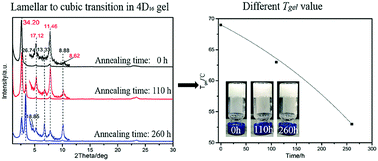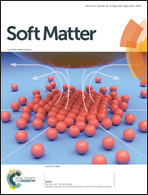Lamellar–cubic transition of a dihydrazide derivative and its effect on the gel stability†
Abstract
N,N′-Bis(4-n-alkyloxybenzoyl)hydrazine (4D16) was demonstrated to show three different aggregates, i.e. a crystalline cubic phase and two kinds of lamellar structure with layer spacings of 34.20 Å (termed the L1 structure) and 40.85 Å (L2 structure) depending on the type of solvents. Lamellar (L1)–crystalline cubic transition during heating was confirmed for 4D16 showing the L1 structure. 4D16 organogels in cyclohexane and benzene exhibited either a mixture of the L1 structure and the crystalline cubic phase or only one of the two structures. 4D16 gels prepared at a higher concentration or a lower incubation temperature consisted of more lamellar L1 structures compared to those obtained at a lower concentration or a higher incubation temperature. Annealing of the as-prepared 4D16 gels at certain temperatures for different time periods caused gradual lamellar L1–cubic transition, and thus increased the content of the cubic phase in the gels, which showed lower Tgel compared to those of the as-prepared ones. The existence of the cubic phase in 4D16 gels in cyclohexane and benzene destabilized the gels.



 Please wait while we load your content...
Please wait while we load your content...